Emily Lakdawalla • Nov 12, 2007
Happy second birthday to Venus Express
Last week, Venus Express passed the two-year mark in space. That spacecraft only took five months to get to Venus orbit, which is just about as fast as you can make it to another planet, which means they've been taking data for more than a year and a half. To celebrate the birthday they released this image, which is composed of about a thousand separate Venus Monitoring Camera observations taken from April to August of this year.

ESA / VMC / MPS / IPF-DLR
Venus Express image of Venus surface temperatures
This map of the surface of Venus is a composite of about 1,000 individual Venus Monitoring Camera (VMC) images taken from April to August 2007. The images were taken at an infrared wavelength of 1 micron, at which Venus' atmosphere is somewhat transparent. The colors correspond to the apparent temperature of the surface; blue colors are areas about 40 degrees Celsius (70 degrees Fahrenheit) cooler than red-orange colors.Then the Venus Express team has another problem that the Cassini team doesn't face. We can see the surface of Venus in this image because we are looking at it using a particular wavelength of light -- about 1 micron -- in which the atmosphere is somewhat transparent. Unfortunately, Venus' surface is so hot that in addition to reflecting incoming sunlight at this wavelength, it also emits thermal radiation at this wavelength. Titan, by contrast, is much colder, so its surface would emit thermal radiation at much longer wavelengths -- I'm not sure exactly what wavelength, but it's probably between 10 and 20 microns. On Venus, as on Earth, cooler temperatures generally prevail at higher elevations.
Then there's a third effect: surface composition. If all of Venus' surface were composed of pretty much the same rocks, then this image would only show temperature-related effects. But if there is any variation in composition across the surface, then the brightness or darkness of any given spot will be related to its composition in addition to its temperature. In fact, there is compelling evidence from Magellan images of Venus taken in the early 1990s that there are compositional variations, particularly at the highest elevations. Iron-bearing minerals -- found everywhere throughout the solar system, and certain to be an important constituent of Venus' surface -- absorb infrared light at a wavelength of around 1 micron.
Despite all these confounding effects, there is not a bad correlation between temperature in the Venus Express image above and topography in the Magellan image below. The blue areas in the Venus Express image correlate with areas of high, mountainous topography, colored red in the Magellan image, while orange areas in the Venus Express image correlate to Venus' broad volcanic lowlands, colored blue and purple in the Magellan image.

NASA / JPL


 Explore Worlds
Explore Worlds Find Life
Find Life Defend Earth
Defend Earth

